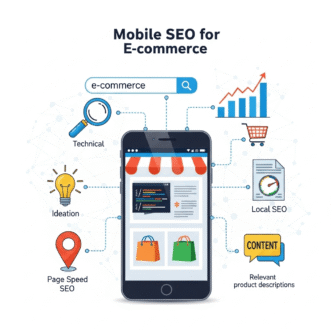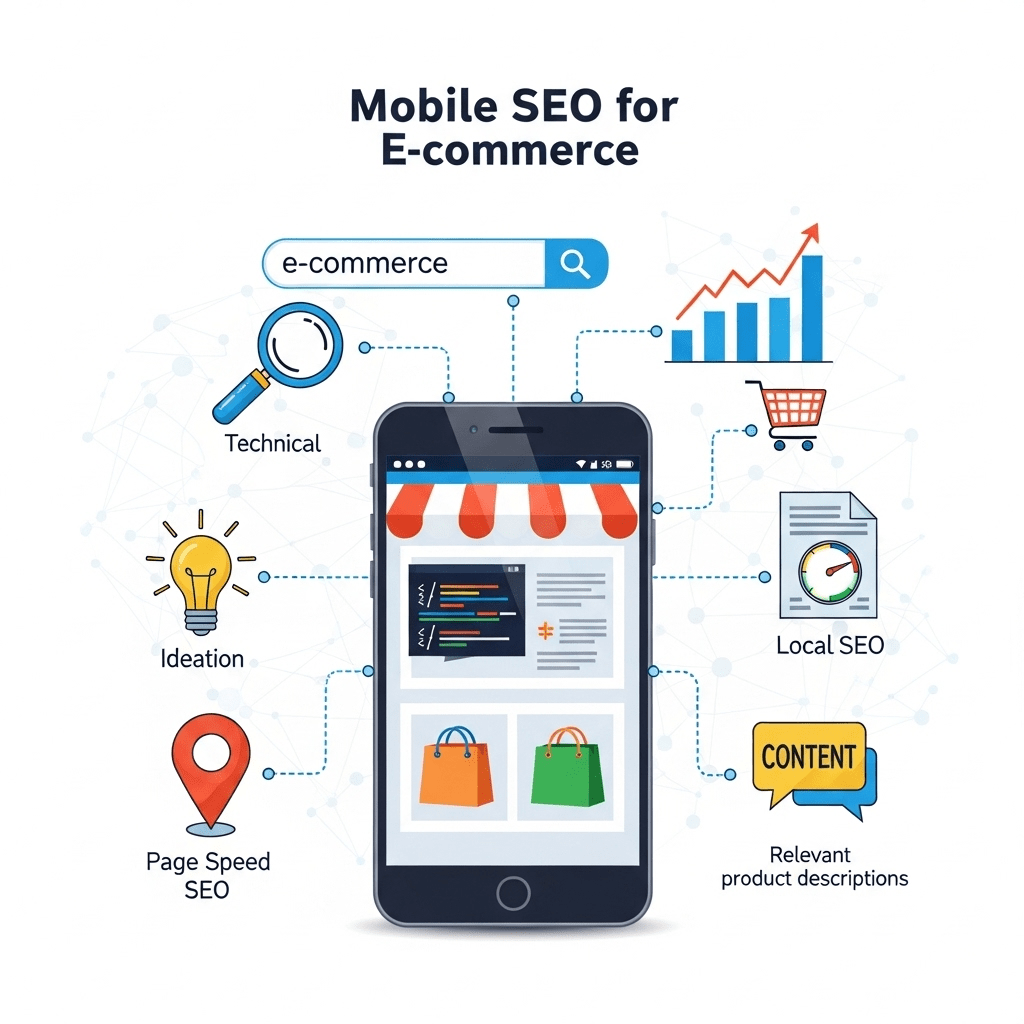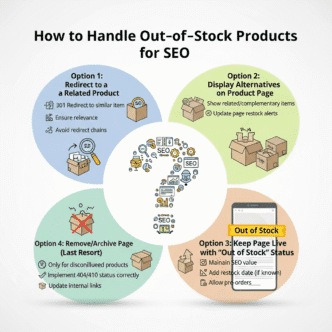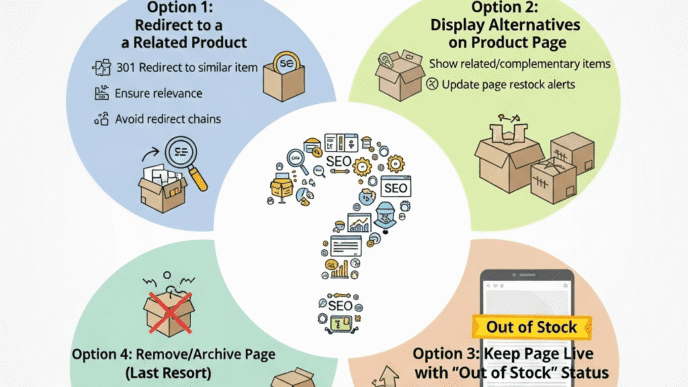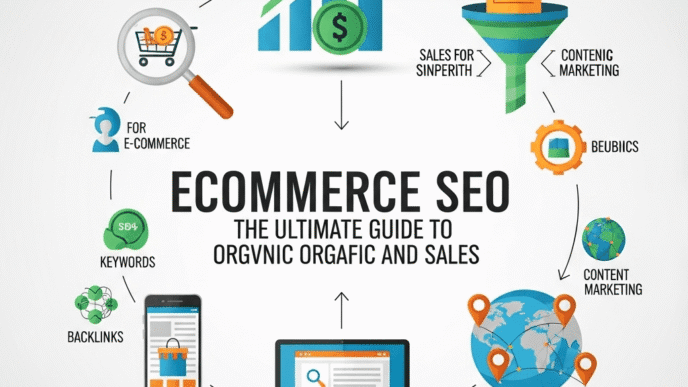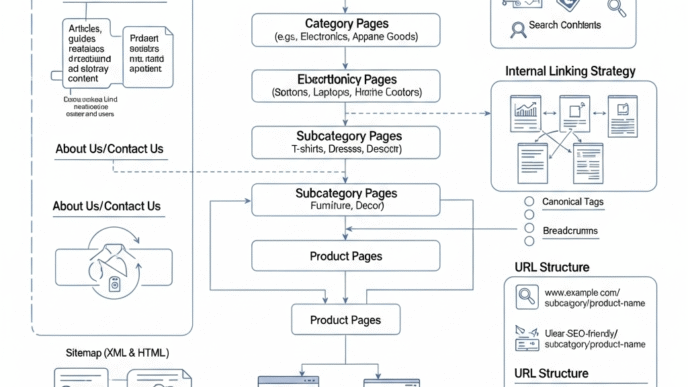Your store looks perfect on desktop. Products display beautifully. Checkout flows smoothly. But when a customer tries to buy on their phone, buttons are microscopic, images take forever to load, and the “Add to Cart” button is buried somewhere they’ll never find.
Welcome to the mobile shopping nightmare costing you 60% of potential sales. According to Statista, mobile commerce now accounts for 60.7% of all ecommerce transactions. If your mobile SEO for ecommerce isn’t flawless, you’re literally watching the majority of customers walk away before they ever buy.
This guide reveals exactly how to optimize ecommerce site for mobile so you capture those sales instead of hemorrhaging them to mobile-friendly competitors. Let’s turn your mobile experience from a conversion killer into a revenue machine.
Table of Contents
Toggle
Why Mobile SEO for Ecommerce Matters More Than Ever
Here’s a stat that should terrify every ecommerce owner: Google now uses mobile-first indexing for all websites. That means Google primarily looks at your mobile site when deciding rankings—not your desktop version.
Translation? If your mobile experience sucks, your rankings tank across all devices. Desktop, tablet, mobile—everything suffers when mobile fails.
The mobile commerce reality:
- 60.7% of ecommerce sales happen on mobile (Statista)
- 53% of mobile users abandon sites taking over 3 seconds to load (Google)
- Mobile conversion rates average 1.82% vs 3.90% on desktop (why?)
- 40% of mobile shoppers will switch to a competitor after a bad experience
But here’s the opportunity: Most online stores have terrible mobile experiences. Fix yours, and you’ll leapfrog competitors still treating mobile as an afterthought.
Pro Tip: According to Google’s research, a 0.1 second improvement in mobile site speed can boost conversion rates by 8% for retail sites. Every millisecond counts when customers are shopping on phones with one thumb while watching TV.
For the complete foundation of ecommerce SEO including mobile optimization, check our ultimate ecommerce SEO guide.
What Is Mobile-First Indexing and Why Should You Care?
Mobile-first indexing means Google predominantly uses the mobile version of your content for indexing and ranking. It’s not “mobile-only”—desktop still matters—but mobile is now the primary evaluation.
How Mobile-First Indexing Works
Before mobile-first: Google crawled desktop → ranked pages → adjusted for mobile
After mobile-first: Google crawls mobile → ranks pages → desktop follows mobile performance
What this means for your store:
- Mobile site must have complete content (not stripped-down version)
- Structured data must work on mobile
- Images must be optimized and fast-loading
- Navigation must be functional on small screens
- Internal linking must work perfectly on mobile
Pro Tip: Use Google Search Console’s Mobile Usability report to identify mobile-specific issues Google discovered while crawling your site. Fix these immediately—they’re directly hurting rankings.
How to Optimize Ecommerce Site for Mobile: The Complete Strategy
Let’s break down mobile-friendly ecommerce best practices into actionable steps you can implement today.
1. Implement Responsive Ecommerce Design
Responsive design means your site automatically adapts to any screen size—phone, tablet, desktop, whatever.
Why responsive beats separate mobile sites:
- One URL structure (better for SEO)
- Consistent content across devices
- Easier maintenance and updates
- Google’s recommended approach
Testing your responsive design:
Chrome DevTools:
1. Right-click page → Inspect
2. Toggle device toolbar (Ctrl+Shift+M)
3. Test various screen sizes
4. Check touch interactions
Critical responsive elements:
- Fluid grids that scale proportionally
- Flexible images that resize properly
- CSS media queries for breakpoints
- Touch-friendly buttons and navigation
- Readable text without zooming
Pro Tip: Don’t just test in Chrome’s device emulator—test on actual devices. I keep old Android and iPhone models specifically for testing because emulators miss real-world issues like slow 4G connections, varied screen resolutions, and actual finger-sized tap targets.
2. Optimize Mobile Site Speed
Mobile site speed is the single most critical factor for mobile success. Slow sites bleed customers and rankings.
Mobile speed benchmarks:
| Metric | Target | Reality (Average) |
|---|---|---|
| First Contentful Paint | Under 1.8s | 3.4s |
| Largest Contentful Paint | Under 2.5s | 4.2s |
| Time to Interactive | Under 3.8s | 7.3s |
| Total Blocking Time | Under 200ms | 400ms+ |
How to improve mobile speed:
Image Optimization (Biggest Impact):
- Compress images under 200KB
- Use WebP format (30% smaller than JPEG)
- Implement lazy loading
- Serve responsive images (correct size for device)
- Use image CDN for faster delivery
Code Optimization:
- Minify CSS and JavaScript
- Defer non-critical JavaScript
- Eliminate render-blocking resources
- Remove unused code and plugins
- Use browser caching
Server Optimization:
- Enable compression (GZIP or Brotli)
- Use Content Delivery Network (CDN)
- Upgrade hosting if needed
- Implement HTTP/2 or HTTP/3
- Reduce server response time (TTFB under 600ms)
Pro Tip: Run Google PageSpeed Insights on your top 10 product pages and category pages. Focus on fixing “red” critical issues first—these have the biggest impact on actual user experience and conversions.
Real example: A fashion retailer compressed product images and implemented lazy loading. Mobile page load time dropped from 6.8 seconds to 2.1 seconds. Mobile conversion rate increased 47% within 8 weeks. Same products, same prices—just faster loading.
3. Design Mobile User Experience That Converts
Mobile user experience determines whether shoppers buy or bounce. Every friction point costs sales.
Touch-Friendly Design:
- Minimum button size: 44×44 pixels (Apple guidelines)
- Adequate spacing between tap targets (8-10 pixels minimum)
- Easy-to-use dropdown menus and selectors
- Swipeable product galleries
- Sticky “Add to Cart” button always visible
Navigation Optimization:
- Hamburger menu for main navigation
- Persistent search bar
- Easy-to-find shopping cart
- Clear breadcrumbs
- One-tap phone numbers and addresses
Checkout Optimization:
- Guest checkout option (don’t force account creation)
- Autofill for addresses and payment
- Large, thumb-friendly form fields
- Minimal form fields (only ask what’s necessary)
- Progress indicators showing checkout steps
- One-click payment options (Apple Pay, Google Pay)
Pro Tip: Implement “click to call” buttons on mobile. When someone taps your phone number, it should instantly dial—no copying and pasting. This simple UX improvement can boost phone orders significantly for stores with customer service teams.
Learn more about optimizing conversion rates in our comprehensive ecommerce SEO guide.
4. Optimize Product Pages for Mobile
Product pages on mobile require special attention since they’re where conversion happens.
Mobile product page essentials:
Images:
- High-quality, fast-loading product photos
- Swipeable galleries (not tiny thumbnails)
- Pinch-to-zoom functionality
- Lifestyle images showing product in use
- 360-degree views or video (if applicable)
Content:
- Scannable bullet points for key features
- Collapsible sections for detailed specs
- Short paragraphs (2-3 sentences maximum)
- Bold important benefits
- Clear pricing and availability
Call-to-Action:
- Prominent “Add to Cart” button (thumb-friendly)
- Size/color selectors easy to use with one hand
- Quantity adjusters large enough to tap accurately
- Trust signals visible (returns, shipping, guarantees)
Pro Tip: Use session recording tools like Hotjar to watch actual customers navigate your mobile product pages. You’ll discover usability issues you’d never find through testing alone—like customers repeatedly mis-tapping buttons or struggling with size selectors.
5. Implement Mobile-Specific Features
Take advantage of mobile-only capabilities to enhance shopping experience.
Mobile-unique features:
- Click-to-call for customer service
- GPS-based store locators
- Camera integration for visual search
- Push notifications for cart abandonment
- Mobile wallet integration (Apple Pay, Google Pay)
- Barcode scanning for product lookup
Pro Tip: Progressive Web Apps (PWAs) combine the best of websites and mobile apps—fast, installable, work offline, and send push notifications. If you have budget for development, PWAs significantly boost mobile engagement and conversion rates.
What Are the Most Common Mobile SEO Mistakes?
Even experienced ecommerce managers make these mobile optimization blunders:
Mistake 1: Blocking CSS, JavaScript, or Images
Google needs to see your full mobile site to properly index it. Blocking resources prevents proper rendering.
Fix: Check robots.txt and ensure nothing critical is blocked. Use Google Search Console’s URL Inspection tool to see what Googlebot sees.
Mistake 2: Using Intrusive Interstitials
Pop-ups that cover the main content on mobile frustrate users and violate Google’s guidelines.
Fix: Delay pop-ups until after meaningful interaction, use banners instead of full-screen overlays, or skip pop-ups on mobile entirely.
Mistake 3: Tiny Text and Buttons
If users need to pinch-zoom to read text or tap buttons, your mobile experience fails.
Fix:
- Font size minimum 16px for body text
- Button minimum 44×44 pixels
- Adequate spacing between tap targets
- Test on actual small-screen devices
Mistake 4: Slow-Loading Product Images
High-resolution images destroy mobile page speed and conversion rates.
Fix: Compress images aggressively, use WebP format, implement lazy loading, serve appropriate sizes for mobile screens.
Mistake 5: Complicated Checkout
Every extra step or required field on mobile checkout increases abandonment dramatically.
Fix: Offer guest checkout, minimize form fields, implement autofill, add one-click payment options, show progress indicators.
Pro Tip: According to Baymard Institute research, the average mobile checkout abandonment rate is 80.8%. The primary reasons? Forms too long, complicated navigation, and forced account creation. Fix these three issues and watch mobile conversions climb.
How Mobile Page Speed Impacts Rankings and Revenue
Let’s talk numbers. Improving mobile conversion rates starts with speed.
The Speed-Revenue Connection
Google’s research shows:
- 53% of mobile users abandon sites taking over 3 seconds
- 1-3 second load time increases bounce probability by 32%
- 1-5 second load time increases bounce probability by 90%
- 1-10 second load time increases bounce probability by 123%
Conversion impact:
- Pages loading in 2 seconds convert at 1.9%
- Pages loading in 5 seconds convert at 0.6%
- That’s a 68% difference in conversion rate from 3 seconds of delay
Real example: Walmart found that every 1 second improvement in page load time increased conversions by 2%. For a billion-dollar retailer, that’s millions in additional revenue from speed optimization alone.
Pro Tip: Don’t obsess over perfect PageSpeed scores (100/100 is nearly impossible for complex ecommerce sites). Focus on Core Web Vitals passing thresholds and actual user experience. A site scoring 75 that loads fast for real users beats a site scoring 95 that feels sluggish.
Core Web Vitals for Mobile
Google’s Core Web Vitals measure actual user experience:
Largest Contentful Paint (LCP):
- Measures: How fast main content loads
- Target: Under 2.5 seconds
- Impact: Most visible to users
Interaction to Next Paint (INP):
- Measures: Responsiveness to user interactions
- Target: Under 200 milliseconds
- Impact: Affects perceived performance
Cumulative Layout Shift (CLS):
- Measures: Visual stability (content jumping)
- Target: Under 0.1
- Impact: Frustration factor
Pro Tip: Use Google Search Console’s Core Web Vitals report to identify which pages fail thresholds. Prioritize fixing pages with high traffic and conversion value first—don’t waste time optimizing pages nobody visits.
Mobile SEO Checklist for Online Stores
Your actionable mobile SEO checklist for online stores:
Technical Mobile SEO
- [ ] Responsive design implemented (no separate mobile site)
- [ ] Viewport meta tag properly configured
- [ ] No unplayable content (Flash, unsupported formats)
- [ ] Font sizes readable (16px minimum)
- [ ] Tap targets minimum 44×44 pixels
- [ ] No horizontal scrolling required
- [ ] Mobile-friendly navigation (hamburger menu)
Performance Optimization
- [ ] Mobile PageSpeed score 75+ (target 90+)
- [ ] Images compressed under 200KB
- [ ] Lazy loading implemented
- [ ] CSS and JavaScript minified
- [ ] Browser caching enabled
- [ ] CDN implemented
- [ ] Core Web Vitals passing
User Experience
- [ ] Buttons and links easily tappable
- [ ] Text readable without zooming
- [ ] No intrusive interstitials blocking content
- [ ] Clear, visible calls-to-action
- [ ] Simple, streamlined checkout
- [ ] Guest checkout option available
- [ ] Autofill enabled for forms
Content and Navigation
- [ ] All desktop content available on mobile
- [ ] Breadcrumb navigation present
- [ ] Search functionality prominent
- [ ] Filter and sort options easy to use
- [ ] Product images swipeable
- [ ] Reviews visible and readable
Testing and Monitoring
- [ ] Tested on actual iOS devices
- [ ] Tested on actual Android devices
- [ ] Tested on slow 4G connection
- [ ] Google Search Console mobile report checked
- [ ] Mobile usability issues addressed
- [ ] Conversion funnel optimized for mobile
For comprehensive mobile integration with overall SEO strategy, see our ecommerce SEO ultimate guide.
How AI Is Transforming Mobile Ecommerce Experience
Artificial intelligence is revolutionizing mobile-friendly ecommerce best practices in significant ways.
AI-Powered Mobile Optimization
Dynamic image optimization:
- AI automatically serves optimal image formats and sizes
- Real-time adaptation based on device and connection speed
- Maintains quality while reducing file sizes
Predictive loading:
- AI predicts what users will click next
- Preloads content before users request it
- Feels instant without wasting bandwidth
Personalized mobile experiences:
- AI customizes layout for individual users
- Smart product recommendations on mobile
- Adaptive search based on behavior
Pro Tip: Tools like Cloudflare Polish use AI to automatically optimize images for mobile devices without manual intervention. Set it and forget it—images are always optimally compressed for the requesting device.
Voice Search and Mobile Shopping
Voice commerce is growing rapidly, with 27% of the global online population using voice search on mobile.
Optimizing for mobile voice search:
- Target conversational, question-based keywords
- Implement FAQ schema markup
- Ensure product information is easily speakable
- Optimize for local “near me” searches
- Create content answering common voice queries
Pro Tip: Test your product pages with Google Assistant or Siri voice search. If voice assistants can’t easily find and describe your products, neither can customers using voice shopping.
AR and Visual Search on Mobile
Augmented reality and visual search are becoming standard mobile shopping features.
Mobile AR applications:
- Virtual try-on for clothing and accessories
- Furniture placement in rooms
- Makeup testing
- Size visualization
Visual search optimization:
- High-quality product images from multiple angles
- Proper image file names and alt text
- Structured data for products
- Clean, uncluttered product photos
Real-World Mobile SEO Success Story
Let’s examine a concrete mobile optimization transformation with measurable results.
The Business: Mid-sized home goods retailer, $5M annual revenue, 3,000 products
The Problem:
- Mobile traffic 67% of total but only 28% of revenue
- Mobile conversion rate: 0.8% (desktop: 3.2%)
- Average mobile page load: 7.4 seconds
- Google Search Console showing 180 mobile usability errors
- Bounce rate on mobile: 74%
The Mobile Overhaul (5-month project):
Month 1: Technical Foundation
- Implemented proper viewport configuration
- Fixed 180 mobile usability errors
- Ensured all desktop content available on mobile
- Added structured data for products
Month 2: Speed Optimization
- Compressed all product images (reduced by 68%)
- Implemented lazy loading
- Minified CSS and JavaScript
- Added Cloudflare CDN
- Reduced mobile load time to 2.3 seconds
Month 3: UX Improvements
- Redesigned mobile navigation (hamburger menu)
- Increased button sizes to 48×48 pixels
- Made product images swipeable
- Implemented sticky “Add to Cart” button
- Removed forced account creation at checkout
Month 4: Checkout Optimization
- Simplified checkout to 3 steps (was 7)
- Added guest checkout option
- Implemented Apple Pay and Google Pay
- Enabled autofill for all forms
- Added progress indicators
Month 5: Testing and Refinement
- A/B tested various mobile layouts
- Used session recordings to identify friction
- Optimized based on user behavior data
- Fine-tuned Core Web Vitals
The Results (6 months post-launch):
- Mobile conversion rate: 0.8% → 2.4% (200% increase)
- Mobile revenue: 28% → 54% of total
- Average order value on mobile increased 18%
- Mobile bounce rate: 74% → 38%
- Organic mobile traffic increased 156%
- Mobile page rankings improved average +12 positions
- Additional annual revenue from mobile optimization: $1.8M
Key Takeaway: They didn’t add new products or change pricing. Simply making the mobile experience fast, frictionless, and user-friendly unlocked millions in trapped revenue that was always there—customers just couldn’t complete purchases on broken mobile experiences.
Tools for Mobile SEO Testing and Monitoring
Free Mobile SEO Tools:
- Google Mobile-Friendly Test – Test individual pages
- Google PageSpeed Insights – Speed analysis and recommendations
- Google Search Console – Mobile usability reports
- Chrome DevTools – Device emulation and testing
Premium Tools:
- GTmetrix – Detailed speed analysis ($10-25/mo)
- Pingdom – Speed monitoring ($10-50/mo)
- BrowserStack – Real device testing ($39-199/mo)
- Hotjar – Session recordings and heatmaps ($39-589/mo)
Pro Tip: Don’t rely solely on testing tools—actually use your site on real mobile devices regularly. Order from your own store on your phone while commuting or waiting in line. You’ll discover UX issues that tools never flag.
Expert Insights on Mobile Ecommerce SEO
Google’s John Mueller:
“Mobile-first indexing means we look at your mobile site first. If something’s broken or missing on mobile but works on desktop, that’s what we’ll see and rank. Mobile isn’t just important—it’s primary.”
Cindy Krum, CEO of MobileMoxie:
“The future of SEO is mobile. Stores that treat mobile as an afterthought or separate entity will struggle. Mobile needs to be your primary development focus, with desktop following mobile design principles.”
Rand Fishkin, founder of SparkToro:
“Mobile page speed isn’t just an SEO factor—it’s a conversion factor, user experience factor, and brand perception factor. Fast mobile sites win on every metric that matters to ecommerce.”
These experts agree: mobile SEO for ecommerce isn’t optional or secondary—it’s the foundation of online retail success in 2025 and beyond.
Frequently Asked Questions
What’s the difference between mobile-friendly and mobile-optimized?
Mobile-friendly means your site works on mobile devices. Mobile-optimized means it’s specifically designed for excellent mobile experience—fast, easy to use, converts well. Aim for optimized, not just friendly.
Should I create a separate mobile site or use responsive design?
Responsive design is strongly recommended. Separate mobile sites (m.yoursite.com) create SEO complications, duplicate content issues, and maintenance headaches. One responsive site is Google’s preferred approach.
How fast should my mobile site load?
Target under 3 seconds for full page load, under 2.5 seconds for Largest Contentful Paint. Faster is always better—every 0.1 second improvement boosts conversions.
Do I need an app or is mobile web enough?
Mobile web reaches more customers (no download required) and is easier to maintain. Apps make sense if you have high repeat purchase rates and can justify development costs. Progressive Web Apps (PWAs) offer middle ground.
How do I test mobile SEO if I don’t have many devices?
Use Chrome DevTools for basic testing, but invest in at least one older Android phone and one older iPhone for real-world testing. Services like BrowserStack provide cloud-based real device testing if budget allows.
Does mobile page speed affect desktop rankings?
Indirectly. Google primarily uses your mobile site for ranking, so poor mobile speed can hurt rankings across all devices. Mobile performance affects overall domain authority.
What’s the biggest mobile SEO mistake ecommerce stores make?
Slow page speed from unoptimized images. This single issue kills more mobile conversions than any other factor and is completely fixable with image compression and lazy loading.
How often should I audit mobile SEO?
Monthly quick checks (Search Console mobile usability report), quarterly comprehensive audits (speed, UX, conversions), and immediate testing whenever you make site changes.
Final Thoughts: Mobile Isn’t the Future—It’s the Present
Mobile SEO for ecommerce isn’t about preparing for tomorrow—it’s about competing today. With 60%+ of sales happening on mobile devices, your mobile experience directly determines whether your store grows or stagnishes.
The brutal reality? Most ecommerce stores have terrible mobile experiences. Slow loading, tiny buttons, complicated checkouts, and frustrating navigation. Your competitive advantage is right there—fix what others ignore.
Start with these priorities:
- Run mobile speed tests on your top 10 pages
- Fix critical Core Web Vitals issues
- Test checkout on actual mobile devices
- Compress and optimize all product images
- Simplify mobile checkout (guest option, fewer fields)
Every improvement compounds. Faster loading leads to lower bounce rates. Better UX leads to higher conversions. More mobile sales lead to stronger business growth.
The stores dominating mobile commerce didn’t get there by accident. They made mobile optimization a priority, invested in speed and UX, and continuously refined based on actual user behavior.
Your mobile experience is costing you sales right now. Every hour you delay optimization is revenue left on the table.
Stop treating mobile as a secondary concern. Start building the mobile shopping experience your customers deserve and your business requires.
Master complete ecommerce SEO: Our comprehensive guide covers technical optimization, keyword research, content strategy, and link building that complement mobile optimization for maximum organic growth.
Get actionable SEO insights: Visit seoprojournal.com for expert guides, case studies, and proven tactics that drive measurable results for online stores.

